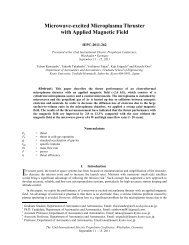Design Development and Test of the RIT-ÁX Mini Ion Engine System
Design Development and Test of the RIT-ÁX Mini Ion Engine System
Design Development and Test of the RIT-ÁX Mini Ion Engine System
Create successful ePaper yourself
Turn your PDF publications into a flip-book with our unique Google optimized e-Paper software.
an efficient ionisation whereas <strong>the</strong> magnetic field is necessary for ECR-Thrusters to establish <strong>the</strong> electron cyclotron<br />
resonance conditions. Using permanent magnets <strong>the</strong> operational temperature <strong>of</strong> <strong>the</strong> thruster is limited to <strong>the</strong><br />
magnet’s Curie temperature TC which is typically in <strong>the</strong> range <strong>of</strong> 300°C. Some Kaufman-<strong>Engine</strong>s omit <strong>the</strong><br />
permanent magnets by using electromagnets with coils instead. The required number <strong>of</strong> turns for <strong>the</strong>se coils makes<br />
an electrical isolation indispensable. Therefore <strong>the</strong> <strong>the</strong>rmal restrictions are quite similar to that <strong>of</strong> permanent<br />
magnets. In contrast, <strong>the</strong> RF-coil <strong>of</strong> <strong>the</strong> <strong>RIT</strong>-Thruster is not covered by isolating materials because <strong>the</strong> distance from<br />
turn to turn is sufficient to achieve isolation.<br />
Inherent High Voltage Isolation: The ionized propellant (plasma) is an excellent electrical conductor. So <strong>the</strong><br />
high voltage provided to <strong>the</strong> screen grid (or an anode) is "visible" for any component in contact with <strong>the</strong> plasma. In<br />
case <strong>of</strong> <strong>the</strong> <strong>RIT</strong> this voltage is inherently isolated from surroundings. The non-conductive ionizer vessel is a natural<br />
barrier. In a <strong>RIT</strong> system only <strong>the</strong> cabling to <strong>the</strong> grid is on high voltage potential. In Kaufman engines also <strong>the</strong> entire<br />
cathode system <strong>and</strong> <strong>the</strong> anode are on high potential. Special care is required, also for <strong>the</strong> layout <strong>of</strong> <strong>the</strong> PPU where<br />
several modules are on high voltage potential [4].<br />
Thrust control: The clear relationship between applied RF-power <strong>and</strong> extractable ion current <strong>and</strong> <strong>the</strong> inherent<br />
stability <strong>of</strong> <strong>the</strong> ionisation <strong>of</strong>fer an effective thrust control strategy. Also without any regulation <strong>the</strong> beam current is<br />
constant as long as no o<strong>the</strong>r operational parameters alter (e.g. mass flow). For example, stability better than 0.3%<br />
over 100h was multiply demonstrated with <strong>the</strong> large <strong>RIT</strong>-22 engine. During this test no active thrust regulation was<br />
employed. With a simple closed loop between ion beam <strong>and</strong> RF-supply a high precision thrust control is realized.<br />
The stability only depends on <strong>the</strong> accuracy <strong>of</strong> <strong>the</strong> employed electronics. Nei<strong>the</strong>r external magnetic fields have to be<br />
controlled nor does any restriction by additional fields apply. Using high precision laboratory power supplies <strong>and</strong> <strong>the</strong><br />
closed loop concept <strong>the</strong> thrust stability achieved with <strong>RIT</strong>-22 is better than 0.1‰ (+/- 1mA @ 2380mA beam current)<br />
Ultra Fast Thrust Control: If <strong>the</strong> rf-power is varied <strong>the</strong> ionization responses to a new equilibrium within some<br />
rf-periods. So within a few microseconds <strong>the</strong> thrust reaches a new state. The time thrust resolution <strong>of</strong> <strong>the</strong> overall<br />
propulsion system depends on <strong>the</strong> speed <strong>of</strong> <strong>the</strong> electronics around <strong>the</strong> engine. It is not limited by <strong>the</strong> thruster itself.<br />
In contrast to <strong>the</strong> rf-ionization any engines requiring cathodes are limited in <strong>the</strong>re response by <strong>the</strong> <strong>the</strong>rmal capacity<br />
<strong>of</strong> <strong>the</strong> cathode.<br />
Thrust noise: The inherent thrust stability in combination with <strong>the</strong> fast thrust response <strong>of</strong>fers excellent low thrust<br />
noise. The extreme low thrust noise is a challenge for any measurement.<br />
IV. <strong>RIT</strong>-µX <strong>Ion</strong> Thruster <strong>System</strong><br />
During <strong>the</strong> system design phase, architectures with two, four, eight <strong>and</strong> twelve engines have been investigated.<br />
The work was performed for three levels <strong>of</strong> thrust. In addition to <strong>the</strong> mini rf-ion engine also power supply <strong>and</strong><br />
control unit PSCU <strong>and</strong> flow control system have been investigated in detail. Results are subject <strong>of</strong> <strong>the</strong> dedicate<br />
<strong>System</strong> <strong>Design</strong> Report. The description in this section is focused on <strong>the</strong> principle function <strong>of</strong> all mini ion engine<br />
system components.<br />
<strong>RIT</strong>A - Radi<strong>of</strong>requecy <strong>Ion</strong> Thruster<br />
Assembly<br />
PPU<br />
- Power<br />
Processing<br />
Unit<br />
FCU<br />
- Flow<br />
Control<br />
Unit<br />
TU<br />
<strong>RIT</strong> Thruster<br />
Unit<br />
- <strong>Ion</strong> Thruster<br />
- Neutralizer<br />
- RF Generator<br />
<strong>RIT</strong>-µX - Radi<strong>of</strong>requecy <strong>Ion</strong> Thruster<br />
Assembly<br />
PPU<br />
- Power<br />
Processing<br />
Unit<br />
FCU<br />
- Flow<br />
Control<br />
Unit<br />
Neutralizer<br />
<strong>RIT</strong>-µX<br />
<strong>RIT</strong> Thruster<br />
Unit<br />
- <strong>Ion</strong> Thruster<br />
- RF Generator<br />
Figure 2 Comparison - Conventional Radio Frequency <strong>Ion</strong> <strong>Engine</strong> <strong>System</strong> (Left) vs. <strong>Mini</strong> <strong>Ion</strong> <strong>Engine</strong> <strong>System</strong><br />
(Right)<br />
4<br />
The 31st International Electric Propulsion Conference, University <strong>of</strong> Michigan, USA<br />
September 20 – 24, 2009






